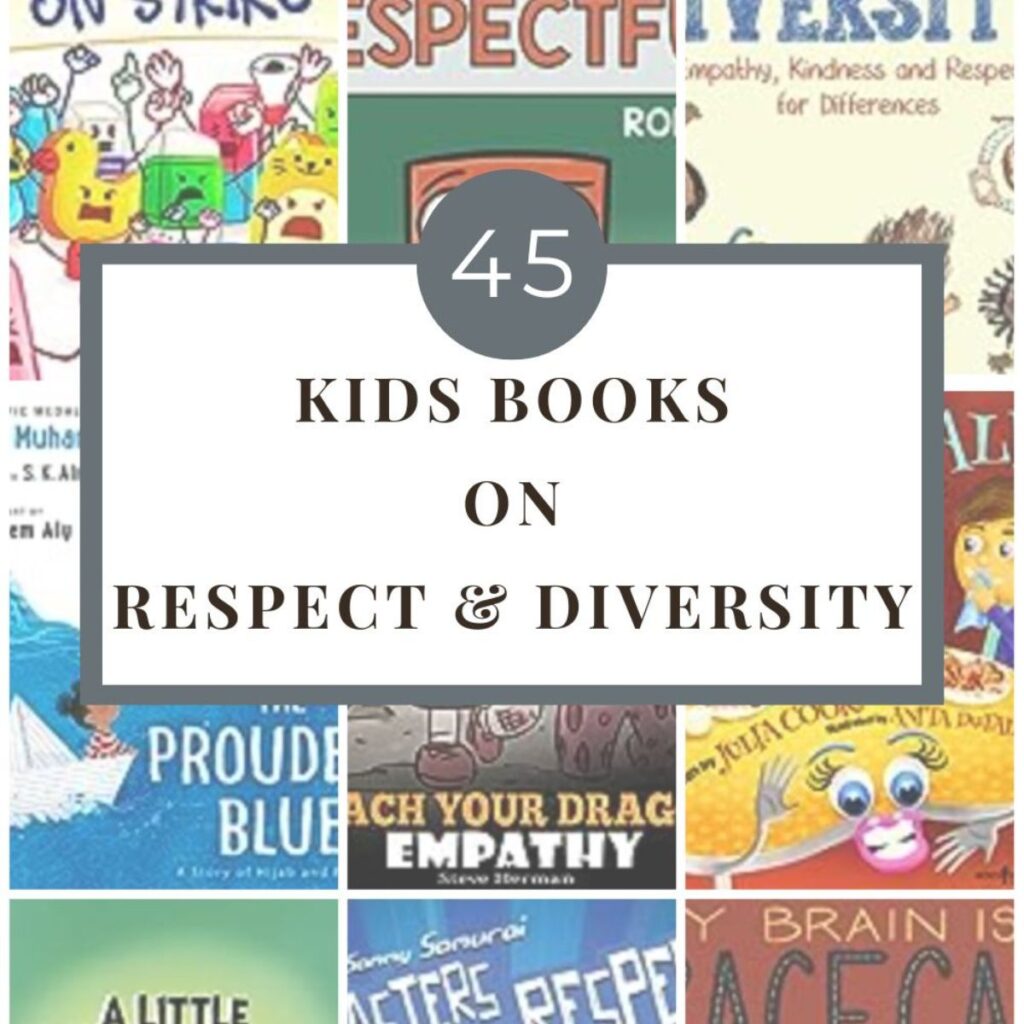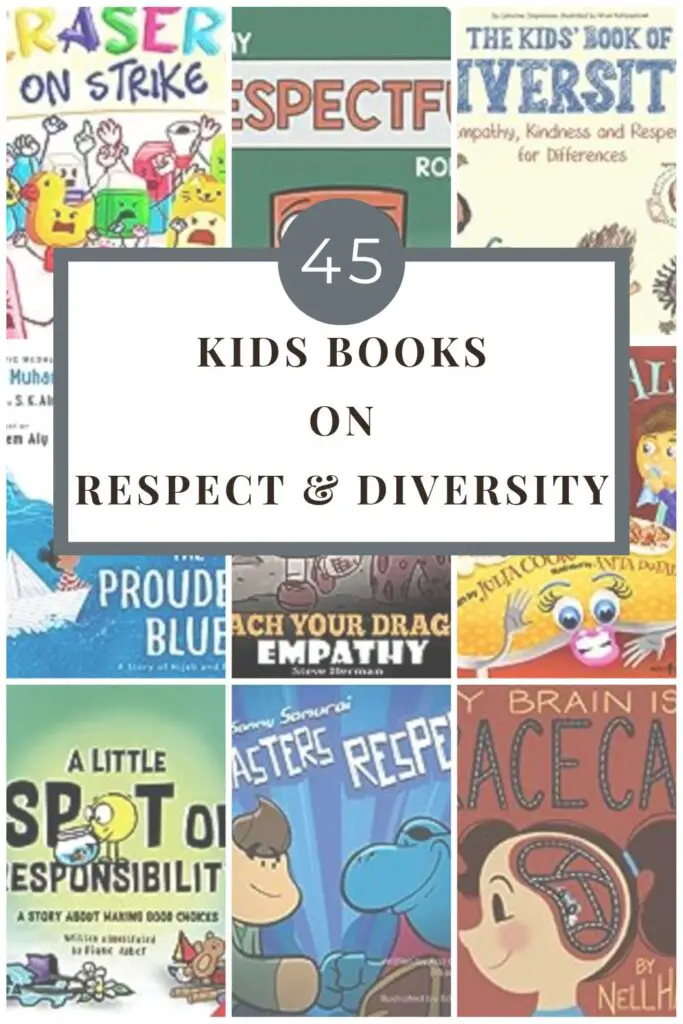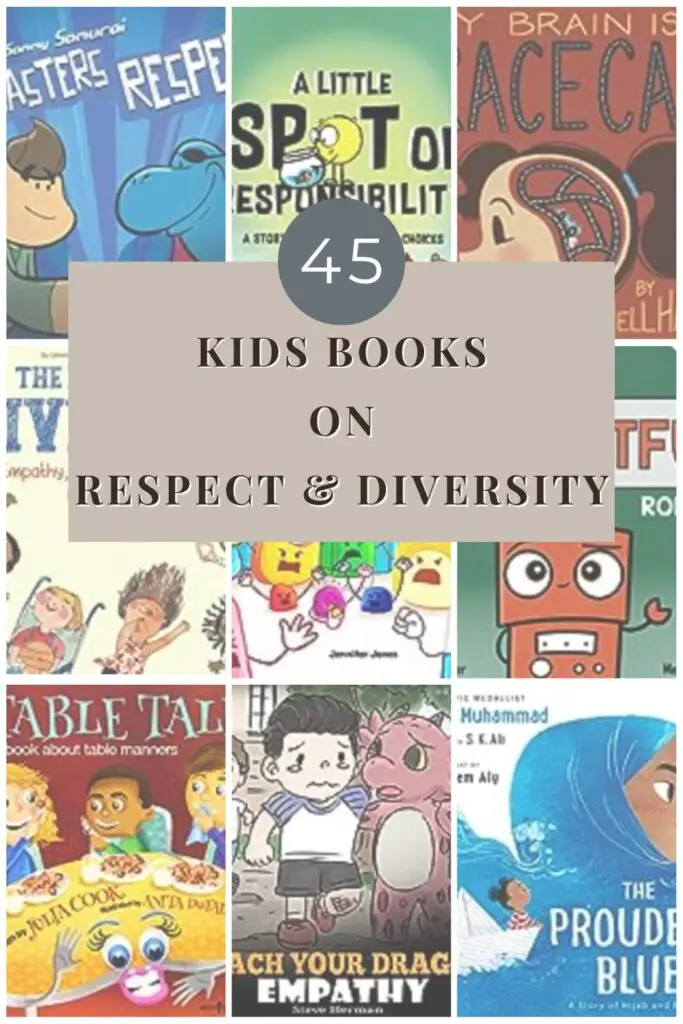In a rapidly evolving global society, imparting the values of respect and embracing diversity to young minds is of paramount importance. Children are naturally curious and open to learning, making their formative years a crucial window for instilling fundamental values that shape their attitudes and behaviors. Teaching children about respect for themselves and others, as well as fostering an understanding of diverse cultures, backgrounds, and perspectives, not only cultivates empathy but also lays the foundation for a harmonious and inclusive future. By equipping children with the tools to navigate differences with kindness and an open heart, we empower them to become compassionate, informed citizens who contribute positively to the world around them.

Discloser Note:
This post may contain affiliate links, which means I make a small commission at no extra cost to you. See my full disclosure here.
Table Of Contents
The Role Of Literature In Shaping Young Minds
Children’s literature serves as a powerful conduit for shaping young minds, allowing them to explore and internalize complex concepts in accessible and engaging ways. Stories have a unique ability to transport children into different worlds, offering windows into experiences they might not encounter in their immediate environments.
Literature serves as a bridge that connects children to characters from diverse backgrounds, helping them relate, empathize, and develop an appreciation for the richness of human differences. Through relatable characters and relatable scenarios, literature provides children with the emotional tools to better understand their own identities and the identities of others, fostering a sense of belonging and inclusion.
Resources For Parents
Two of my favorite resources for parents or care givers who want to better understand the importance of literature and reading aloud for children are Jim Trelease’s Read Aloud Handbook: Eighth Edition and Sarah Mackenzie’s The Read-Aloud Family: Making Meaningful and Lasting Connections with Your Kids.


The Power Of Representation
Including diverse characters and experiences in children’s books not only reflects the reality of our interconnected world but also offers a platform for introducing young readers to a multitude of cultures, traditions, and perspectives. This approach to storytelling sends an important message: that all children’s stories are worth telling and that every child’s experiences are valid and valued.
Representation in children’s literature goes beyond personal validation – it has the power to be an important lesson in breaking stereotypes and cultivating empathy. When young children are exposed to characters from different walks of life and backgrounds, they learn that individuals are not defined by a single narrative or preconceived notions. By encountering stories that challenge stereotypes and highlight the complexities of people’s lives, children develop an understanding that everyone’s journey is unique. These great books create bridges of understanding, allowing young readers to walk in the shoes of characters unlike themselves, fostering empathy and broadening their horizons.
Key Themes In Respect And Diversity
Incorporating essential themes such as kindness, empathy, acceptance, and inclusion into children’s books is a great way to equip young minds with the tools they need to navigate the world around them. These awesome children’s books serve as a window into different ways of interacting with others and approaching life’s challenges. By illustrating the golden rule of treating others as they would like to be treated, these stories teach children the value of kind words, good manners, and making good choices. Characters who demonstrate empathy and embrace differences become relatable role models, encouraging young readers to embrace these important values in their own lives. These picture books go beyond entertainment; they lay the foundation for crucial social skills that contribute to positive relationships and effective conflict resolution.
Introducing The Themes At An Early Age
The early years of a child’s development are a big deal when it comes to shaping attitudes and behaviors. Introducing themes of kindness, empathy, acceptance, and inclusion through children’s books is one of the best ways to lay the groundwork for a more inclusive society. By exposing young children to diverse perspectives and portraying characters who prioritize understanding and acceptance, we establish a strong foundation for them to grow into open-minded, compassionate individuals. These important issues can be introduced through relatable storylines, making it easier for children to grasp the significance of embracing differences and treating others with respect. By nurturing these values from an early age, we contribute to the creation of a future generation that not only values diversity but actively works towards creating a more harmonious and inclusive world.
Kids’ Books About Respect
When children are immersed in books that model mutual respect, positive communication, and empathy, they are exposed to a variety of situations that stimulate their cognitive growth. Through the lens of well-crafted stories, children gain insights into complex emotions and different perspectives, fostering their ability to understand the world around them. These experiences create vivid memories, forming a rich foundation upon which they can build a framework for effective communication, critical thinking, and problem-solving. As children respect and connect with the characters in their favorite books, they learn by example the value of treating others with kindness and respect, translating these lessons into their real-world interactions.
Being Nice to Others: A Book about Rudeness (Growing God’s Kids)

Little Sammy Samurai Masters Respect: A Children’s Book About Kindness

Rulers On Strike: A Funny, Rhyming, Read Aloud Kid’s Book About Respect and Responsibility

Scissors on Strike: A Funny, Rhyming, Read Aloud Kid’s Book About Respect and Kindness

Erasers On Strike: A Funny, Rhyming, Read Aloud Kid’s Book About Respect and Responsibility

Crayons on Strike: A Funny, Rhyming, Read Aloud Kid’s Book About Respect and Kindness

A Little SPOT of Responsibility: A Story About Making Good Choices

Why Should I?: A book about respect (Our Emotions and Behavior)

Respectful Ninja: A Children’s Book About Showing and Giving Respect

I Choose to Be Respectful: A Colorful, Rhyming Picture Book About Respect

The Berenstain Bears Respect Each Other

Teach Your Dragon Respect: A Story About Being Respectful

Respect – The Best Me That I Can Be

The Berenstain Bears Show Some Respect

A Little Respectful SPOT: A Story About Respecting People, Places, and Things


List Of Books About Diversity
Storytelling holds immense power in building empathy, understanding, and open-mindedness in children. When they immerse themselves in narratives that portray characters from diverse backgrounds facing various challenges, children learn to relate and empathize with others’ experiences. As they connect emotionally with characters who navigate different circumstances, they acquire a deeper understanding of the complexities of human emotions and motivations. These stories provide a safe space for children to explore different perspectives, encouraging them to question assumptions and embrace open-mindedness. Through the exploration of various narratives, children develop an inherent sense of empathy, recognizing that everyone’s story is unique, and that embracing diversity enriches their understanding of the world.
My Brain is a Race Car: A children’s guide to a neuro-divergent brain

Acceptance Is My Superpower: A Children’s Book About Diversity and Equality

Masterpiece: an inclusive kids book celebrating a child on the autism spectrum

The Kids’ Book of Diversity: Empathy, Kindness and Respect for Differences

The Girl Who Thought in Pictures: The Story of Dr. Temple Grandin

Proudest Blue

Neurodivergent Ninja: A Children’s Book About the Gifts of Neurodiversity

Diversity Ninja: An Anti-Racist, Diverse Children’s Book About Racism, Prejudice, Equality, and Inclusion

Uniquely Wired: A Story About Autism and Its Gifts

Dragon and His Friend: A Dragon Book About Autism

Inclusive Ninja: An Anti-Bullying Children’s Book About Inclusion, Compassion, and Diversity

Cute Books About Manners
Picture books have the power to teach young kids valuable lessons in a fun way, introducing them to new things and important messages. With the help of books, character education lessons come to life as colorful pages depict relatable scenarios that illustrate the significance of good manners. These engaging stories provide a good example for children, showing them how to navigate social interactions and make positive choices. Through the magic of storytelling, even early readers can grasp basic rules of etiquette and courtesy, internalizing these lessons as they follow the adventures of characters who demonstrate the best ways to interact with others. By immersing themselves in these delightful narratives, children not only explore new worlds but also develop their own sense of character, enabling them to apply these positive behaviors in their everyday lives.
My Way to Good Manners: Kids Book about Manners, Etiquette and Behavior that Teaches Children Social Skills, Respect and Kindness

My Respectful Robot: A Children’s Social Emotional Learning Book About Manners and Respect

A Child’s Book of Manners

Margaret Wise Brown’s Manners

Dude, That’s Rude!: (Get Some Manners)

Good Manners For Dinosaurs: Funny Questions About Good Behaviour For Preschool Kids.

Table Talk: A Book about Table Manners

Do Unto Otters (A Book About Manners)

The Berenstain Bears Forget Their Manners

Book Recommendations On Kindness And Empathy
Books are an invaluable tool for introducing young readers to the important issue of kindness and empathy. As children follow the journey of the main character in a sweet story, they embark on a journey of understanding that unfolds from a young age. Through relatable situations and interactions, these cute stories offer a window into the consequences of thoughtless behavior, teaching life skills that are crucial for building positive relationships. Readers learn what it means to be a good friend, respecting personal space and treating others in a respectful way. These narratives address big problems in a relatable manner, providing a great discussion point for caregivers, educators, and children to delve into the concept of respect, foster empathy, and reinforce the importance of treating others as they would like to be treated.
Bucket Filling from A to Z: The Key to Being Happy

What Are Hands For? Board Book: Training Young Hearts

Your Ears Are Made For Listening: Children’s Book About Empathy and Paying Attention to Others

Fill a Bucket: A Guide to Daily Happiness for Young Children

Sammy the Good Sport: Kids Book about Sportsmanship, Kindness, Respect and Perseverance

What Were You Thinking?: Learning to Control Your Impulses

The Kids’ Book of Kindness: Emotions, Empathy and How to Be Kind

I Feel with My Heart: Children’s Picture Book About Empathy, Kindness and Friendship for Preschool

The Little Red Pickup Truck: A children’s book about the power of kindness, compassion and empathy.

Teach Your Dragon Empathy: Help Your Dragon Understand Empathy: A Cute Children Story to Teach Kids Empathy, Compassion, and Kindness

The Role Of Parents, Caregivers, and Educators
Parents, caregivers, and educators serve as essential guides in shaping children’s reading choices. By actively participating in selecting books that celebrate respect and diversity, they become gatekeepers to meaningful learning experiences. Their involvement extends beyond choosing literature; it involves fostering a lifelong love for exploring different perspectives. Through shared reading sessions and engaging conversations, adults can open doors to understanding and empathy, imparting values that will shape children’s interactions with the world around them.
Tips for Initiating Discussions and Activities
After reading books that highlight respect and diversity, initiating discussions and activities adds depth to the learning process. One effective tip is to ask open-ended questions that encourage children to reflect on the characters’ experiences. Engaging them in creative activities such as drawing, writing, or role-playing can provide avenues for personal expression and deeper comprehension. Exploring cultural elements introduced in the stories can also be a fun and enlightening activity, broadening children’s horizons and teaching them to appreciate differences.
Importance of Creating a Safe Space
Creating a safe space is paramount when fostering discussions about respect and diversity. Children should feel comfortable expressing their thoughts, questions, and uncertainties without fear of judgment. An atmosphere of openness enables them to delve into complex subjects, share their insights, and seek guidance when needed. This safe environment nurtures a curiosity-driven learning process, encouraging children to embrace their own identity while respecting and understanding others’. Such spaces help young minds flourish, allowing them to engage thoughtfully with the world’s complexities.
Guiding Children Through Exploration
Navigating respect and diversity through literature involves more than just reading; it’s about guiding children on a journey of exploration. Parents, caregivers, and educators who emphasize the importance of respect and diversity contribute to raising empathetic and culturally sensitive individuals. By fostering discussions, sparking creativity, and creating safe spaces, these adults provide the scaffolding for young minds to develop into compassionate citizens who celebrate differences and approach the world with understanding.


Leave a Reply